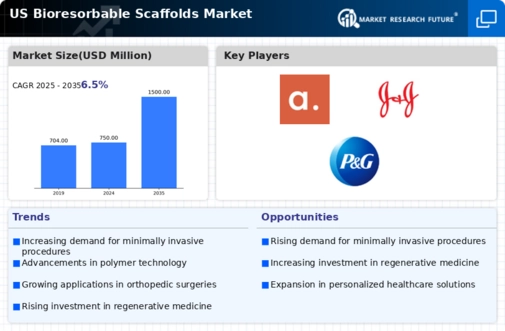Advancements in Biomaterials
Innovations in biomaterials are significantly influencing the bioresorbable scaffolds market. The development of new polymers and composite materials enhances the mechanical properties and biocompatibility of scaffolds, making them more effective for various applications. For instance, the introduction of polycaprolactone and polylactic acid has shown promising results in tissue engineering. As these materials continue to evolve, they are expected to expand the range of applications for bioresorbable scaffolds, particularly in orthopedics and cardiovascular fields. The market for biomaterials is anticipated to reach $150 billion by 2026, indicating a robust growth trajectory that will likely benefit the bioresorbable scaffolds market.
Increased Focus on Regenerative Medicine
The growing emphasis on regenerative medicine is a crucial driver for the bioresorbable scaffolds market. As the healthcare industry shifts towards therapies that promote healing and tissue regeneration, bioresorbable scaffolds are becoming integral to these approaches. They provide a temporary structure that supports cell growth and tissue formation, which is essential in regenerative applications. The regenerative medicine market is projected to exceed $100 billion by 2025, suggesting a substantial opportunity for bioresorbable scaffolds to play a vital role in this expanding sector. This focus on healing rather than merely treating symptoms aligns well with the capabilities of bioresorbable scaffolds.
Growing Investment in Research and Development
Investment in research and development (R&D) within the bioresorbable scaffolds market is a key driver of growth. Increased funding from both public and private sectors is facilitating advancements in scaffold technology, leading to improved designs and functionalities. This investment is crucial for developing new applications and enhancing existing products, thereby expanding market reach. The National Institutes of Health (NIH) has allocated substantial resources towards tissue engineering research, which includes bioresorbable scaffolds. As R&D efforts continue to flourish, the market is likely to witness innovative products that meet the evolving needs of healthcare providers and patients.
Rising Demand for Minimally Invasive Procedures
The increasing preference for minimally invasive surgical techniques is a pivotal driver for the bioresorbable scaffolds market. These procedures are associated with reduced recovery times, lower risk of infection, and minimal scarring. As healthcare providers and patients alike seek less traumatic options, the demand for bioresorbable scaffolds, which facilitate tissue regeneration without the need for permanent implants, is likely to rise. According to recent data, the market for minimally invasive surgeries is projected to grow at a CAGR of approximately 10% over the next few years. This trend suggests a corresponding increase in the bioresorbable scaffolds market, as these products align well with the goals of minimally invasive techniques.
Surge in Sports Injuries and Orthopedic Conditions
The rising incidence of sports injuries and orthopedic conditions is driving demand for bioresorbable scaffolds. As more individuals engage in physical activities, the need for effective treatment options for injuries such as ligament tears and fractures increases. Bioresorbable scaffolds offer a solution by providing structural support during the healing process without the complications associated with permanent implants. The orthopedic device market is expected to grow significantly, with projections indicating a value of $60 billion by 2025. This growth is likely to positively impact the bioresorbable scaffolds market, as healthcare providers seek innovative solutions for injury management.

















Leave a Comment